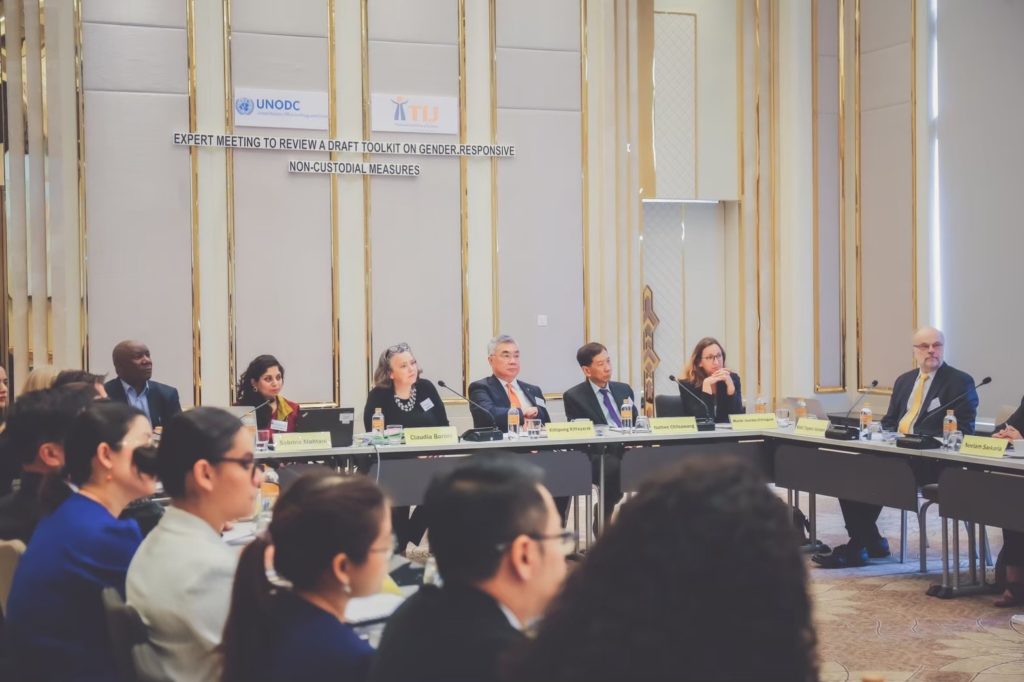
Sabrina Mahtani on Gender & Prison Alternatives
The U.N. Office on Drugs and Crime and the Thailand Institute of Justice recently released a Toolkit on Gender-Responsive Non-Custodial Measures, a handbook with information and guidance on alternatives to incarceration. Part of a Criminal Justice Handbook Series, the toolkit approaches incarceration as a last resort, providing support and guidance to make sure that women are not detained or imprisoned unnecessarily. “Now more than ever, with the outbreak of the Coronavirus pandemic, there is a need to look towards non-custodial measures for women offenders to reduce the burden on the criminal justice system, maintain the health and safety of those in prison and ensure effective rehabilitation,” says the press release on the Thailand Institute of Justice’s website.
Human rights lawyer Sabrina Mahtani led the drafting and research, which took place in large part at Harvard Law School while she was a joint Fellow-in-Residence in the Human Rights Program and the Office of Public Interest Advising. You can learn more about Sabrina at the end of this post.
Sabrina recently spoke with HRP about developing the toolkit and where she hopes it will make the most impact.

Human Rights Program: What are “gender-responsive non-custodial measures” and why are they important?
Sabrina Mahtani: Women are the fastest growing prison population around the world. We have found that factors like poverty, discrimination, and violence exacerbate and lead to this statistic.
In many countries, women prisoners are disproportionately affected by sexual abuse, harassment, and humiliation as compared to men. They are at particular risk of rape, sexual assault, exploitation, and humiliation by male fellow prisoners and prison staff. Imprisonment can have a traumatic impact on children who are separated from their mothers due to imprisonment, which can lead to emotional and developmental problems. The large majority of existing prisons were designed for men and many prisons do not meet the specific needs for women, such as gender-specific health care. Women who are admitted to prison are more likely than men to suffer from mental health problems. Research has shown a higher risk of women prisoners harming themselves or attempting suicide in comparison to male prisoners.
Prison is harmful and costly, to the State but more importantly, to people. Thirty years ago, the United Nations (UN) adopted Standard Minimum Rules for Non-custodial Measures (the Tokyo Rules) to encourage alternatives to imprisonment. Since then, little progress has been made to promote such alternatives; and moreover, these measures did not take into account the specific needs or backgrounds of women. Ten years ago, the UN adopted specific standards for the treatment of women in detention (the Bangkok Rules). These aimed to address the gap in international standards protecting women who come into contact with the criminal justice system and to recommend the use of alternatives to incarceration, leaving imprisonment as a last resort.
However, alternatives to imprisonment are rarely designed for or geared towards women. This means that many non-custodial measures and sanctions overlook the typical characteristics, roles, and backgrounds of women. Furthermore, such measures can be implemented in a way which causes more harm to women or imposes a different form of harm or control by the State.
The community is better served by community-based interventions which address the underlying drivers of why women come into contact with the law, such as poverty, abuse or drug use.
COVID-19 has shown us how urgent it is to implement alternatives to incarceration. WHO, UNODC, UNAIDS and OHCHR have called on States to implement measures to reduce overcrowding in prisons. Between March and June, approximately 639,000 people were released worldwide – constituting only 5.8 per cent of the global prison population. But we should ask ourselves, did these people need to be in prison in the first place? Why have we accepted mass incarceration as a solution?
HRP: How did you first get involved in putting together this toolkit?
SM: I have worked with women in the criminal justice system and against the overincarceration of women for over 15 years. I became a lawyer and involved in this work following personal experience of having a family member imprisoned. I co-founded AdvocAid in 2006 which provides access to justice for women and girls in contact with the law in Sierra Leone. I’ve seen first-hand the devastating impact of prison on women, their children, and the wider community. It was a privilege to work with UNODC and the Thailand Institute of Justice (TIJ) on this Toolkit and to bring more attention to why we need to rethink our approach to the criminal justice.
HRP: Who is the audience and what are you hoping they take away from it?
SM: The Toolkit is aimed at practitioners working in the criminal justice system – prosecutors, defence lawyers, judges, probation officers and civil society groups for example. It provides practical suggestions on how to better implement gender-responsive alternatives to imprisonment. It contains many comparative best practice examples from around the world.
For example, Costa Rica introduced a program through the Public Defender’s Office which works to divert marginalized women away from the criminal justice system and offer them services such as counselling, drug treatment, and job training.
In Australia, the organization Sisters Inside, a civil society organization led by a woman with lived prison experience, goes into the police station daily to meet with all women and girls taken into custody. Workers ensure that detained women and girls’ human rights are being protected, including ensuring they have access to legal representation when they first appear in court. Workers proactively address potential barriers to bail for each woman or girl, including arranging post-release accommodation and advocating for them in court. Workers also support participants to meet the conditions of their bail (e.g. such as transporting them to report to police or arranging ongoing accommodation) and, if they wish, assist them to address the often multiple and compounding causes of their criminalization (e.g. poverty or homelessness). These programs also have a gender-transformative effect and provide supplementary education on gender to police.
The Toolkit is also aimed at policy makers. A stumbling block to implementing alternatives to imprisonment is not having the necessary laws, policies or resources. For example, mandatory sentencing is a major problem and means that gender-specific mitigating factors (such as a history of violence or abuse or caretaking responsibilities) cannot be taken into account.
It should also be a useful resource for law students, helping them better understand and respond to gender discrimination in the criminal justice system.
HRP: Reflecting on the methodology and process, what are your key takeaways from the experience of putting together this research? What are next steps for work in this area?
SM: The research was challenging. This is an area where there is limited research and studies are not often disaggregated by gender. It was hard to find examples that were not from the USA or the UK. Coming from Zambia myself, I was keen for this to be a global Toolkit and to include recommendations and examples that would be useful to a variety of countries.
One of the most useful and rewarding aspects of this research was expanding my network of experts, particularly women with lived experience of the criminal justice system. The draft Toolkit substantially benefited from a review and input by experts in Bangkok in August 2019.
The importance of involving and listening to women with lived experience is stressed in the Toolkit as well as the use of language. Words such as “inmate” or “offender” are dehumanising and place all the blame on the woman rather than looking at the wider issues which lead to women’s imprisonment. An important and easy step we can take is to use more empowering language during work and discussions in this space.
In terms of next steps, we hope to put the Toolkit into practice. UNODC and TIJ have some pilot programs they are implementing. It is important that the Toolkit create change and not be another document to be filed away.
With funding and support, I am keen to do more in-depth research in this often neglected area.
HRP: You worked with a research assistant, Charmaine Archer JD’19. What key insights and experience did Charmaine bring to the table?
SM: It was a pleasure to work with Charmaine. Her fluency in Spanish and experience working in Latin America were extremely useful to the research. She ensured we had best practice examples from this region, in addition to directing me toward helpful examples domestically in the U.S.
Charmaine acted as a fantastic interlocutor who I could bounce ideas off of, helping me to translate expertise for different audiences. She has continued to pursue this line of work, having spent the last year in Ecuador, where she researched how to apply international human rights law in court to advocate for reparative measures for victims of gender-based violence. I’m thrilled this has helped fuel a passion in Charmaine, who is now hoping begin a career in family law in the U.S.
—
To learn more about the Toolkit, watch the recent webinar series from UNODC and TIJ that discusses the Toolkit and gender-responsive criminal justice reform.
Sabrina Mahtani currently works for The Elders as a Senior Policy Advisor on Access to Justice. She previously worked at Amnesty International, leading the organization’s research and advocacy work on Anglophone West Africa.
Sabrina is also the co-founder of the award winning NGO, AdvocAid, which is the only holistic organization in West Africa providing access to justice, education and empowerment for women in the criminal justice in Sierra Leone. The organization has freed six women on death row and provided legal aid to over 4000 women. She previously worked at the Special Court for Sierra Leone and International Criminal Tribunal for Rwanda. Sabrina is a regular writer and commentator on human rights issues and has written for a variety of publications, including Al Jazeera, African Arguments, The Africa Portal, and New Internationalist. She has worked on a number of human rights documentaries and created the first legal education TV series in Sierra Leone.
She holds a BA in Law and History from University College London and an LL.M. from New York University.
Sabrina’s answers to the above questions were written in a personal capacity and does not reflect the views of UNOC or TIJ. You can reach Sabrina Mahtani on twitter as @sabrina_mahtani
